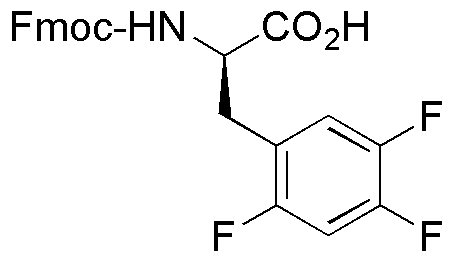Fmoc-D-2,4,5-trifluorophenylalanine is widely utilized in research focused on:
- Peptide Synthesis: This compound serves as a key building block in the synthesis of peptides, particularly in the development of pharmaceuticals and biologically active compounds.
- Drug Development: Its unique trifluorophenyl group enhances the bioactivity of peptides, making it valuable in the design of new drugs targeting specific diseases.
- Bioconjugation: The Fmoc protecting group allows for selective reactions, facilitating the attachment of peptides to other molecules, which is crucial in creating targeted therapies.
- Research in Fluorinated Compounds: The incorporation of fluorine atoms can improve the metabolic stability of compounds, making it a focus in medicinal chemistry for enhancing drug efficacy.
- Protein Engineering: This compound is used in modifying proteins to study their structure and function, aiding in the development of novel biotechnological applications.
General Information
Properties
Safety and Regulations
Applications
Fmoc-D-2,4,5-trifluorophenylalanine is widely utilized in research focused on:
- Peptide Synthesis: This compound serves as a key building block in the synthesis of peptides, particularly in the development of pharmaceuticals and biologically active compounds.
- Drug Development: Its unique trifluorophenyl group enhances the bioactivity of peptides, making it valuable in the design of new drugs targeting specific diseases.
- Bioconjugation: The Fmoc protecting group allows for selective reactions, facilitating the attachment of peptides to other molecules, which is crucial in creating targeted therapies.
- Research in Fluorinated Compounds: The incorporation of fluorine atoms can improve the metabolic stability of compounds, making it a focus in medicinal chemistry for enhancing drug efficacy.
- Protein Engineering: This compound is used in modifying proteins to study their structure and function, aiding in the development of novel biotechnological applications.
Documents
Safety Data Sheets (SDS)
The SDS provides comprehensive safety information on handling, storage, and disposal of the product.
Product Specification (PS)
The PS provides a comprehensive breakdown of the product’s properties, including chemical composition, physical state, purity, and storage requirements. It also details acceptable quality ranges and the product's intended applications.
Certificates of Analysis (COA)
Search for Certificates of Analysis (COA) by entering the products Lot Number. Lot and Batch Numbers can be found on a product’s label following the words ‘Lot’ or ‘Batch’.
*Catalog Number
*Lot Number
Certificates Of Origin (COO)
This COO confirms the country where the product was manufactured, and also details the materials and components used in it and whether it is derived from natural, synthetic, or other specific sources. This certificate may be required for customs, trade, and regulatory compliance.
*Catalog Number
*Lot Number
Safety Data Sheets (SDS)
The SDS provides comprehensive safety information on handling, storage, and disposal of the product.
DownloadProduct Specification (PS)
The PS provides a comprehensive breakdown of the product’s properties, including chemical composition, physical state, purity, and storage requirements. It also details acceptable quality ranges and the product's intended applications.
DownloadCertificates of Analysis (COA)
Search for Certificates of Analysis (COA) by entering the products Lot Number. Lot and Batch Numbers can be found on a product’s label following the words ‘Lot’ or ‘Batch’.
*Catalog Number
*Lot Number
Certificates Of Origin (COO)
This COO confirms the country where the product was manufactured, and also details the materials and components used in it and whether it is derived from natural, synthetic, or other specific sources. This certificate may be required for customs, trade, and regulatory compliance.


